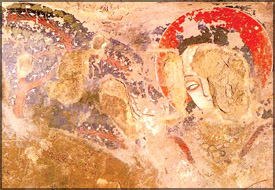|
Bamiyan Statues:
The treasure that was lost to the world
If I ask you what the most significant world event in 2001 was, most
of you are sure to say "the attack on New York's World Trade Centre on
September 11". Many other incidents will also be highlighted by some of
you, while some of you may not remember anything at all.
  Another incident which was just as significant and tragic as the
September 11 attacks was the destruction of the historic Bamiyan Statues
of Afghanistan. Another incident which was just as significant and tragic as the
September 11 attacks was the destruction of the historic Bamiyan Statues
of Afghanistan.
The ancient statues, which were said to be the tallest standing
Buddha statues in the world, were intentionally destroyed by the Taliban
(a hardline Muslim organisation that ruled Afghanistan from 1996 to
2001). Let me tell you about these great statues today.
The Bamiyan (also written as Bamyan) statues were carved into the
side of a cliff in the Bamiyan Valley in the Hazarajat region of central
Afghanistan, situated 230 km (143 miles) northwest of the capital Kabul,
at an altitude of 2,500 metres (8,202 ft). Built during the sixth
century, the statues represented the classic blended style of Indo-Greek
art.
The giant Buddha statues were among Asia's great archaeological
treasures. The main bodies were carved directly from the sandstone
cliffs, but details were modelled in mud mixed with straw and coated
with stucco (a material used as a coating for walls and ceilings).
This coating, practically all of which was worn away long ago, was
painted to enhance the expressions of the faces, hands and folds of the
robes of the statues. The lower parts of the statues' arms were
constructed from the same mud-straw mix while supported on wooden
armatures (internal framework of a piece of sculpture).
It is believed that the upper parts of their faces were made from
great wooden masks or casts. The rows of holes that could be seen in
photographs were spaces that held wooden pegs which served to stabilise
the outer stucco.
Central Afghanistan was strategically placed to prosper from the Silk
Road caravans which criss-crossed the region, trading between the Roman
Empire, China and India. One of the stopping-off points for these
traders was the old kingdom of Kushan, whose people were responsible for
carving these wonders of the ancient world.
  The larger statue stood at 53 metres (125 feet) above the town of
Bamiyan - as high as a 10-storey building - and was considered to be the
most remarkable representation of the Buddha anywhere in the world.
Once, this statue and its 38-metre-high companion were painted in gold
and other colours, and were decorated in dazzling ornaments. All around,
there was a mixture of Greek, Persian and Central and South Asian art. The larger statue stood at 53 metres (125 feet) above the town of
Bamiyan - as high as a 10-storey building - and was considered to be the
most remarkable representation of the Buddha anywhere in the world.
Once, this statue and its 38-metre-high companion were painted in gold
and other colours, and were decorated in dazzling ornaments. All around,
there was a mixture of Greek, Persian and Central and South Asian art.
There were a countless number of rich frescoes. On one cave wall,
there remain traces of a painting of the Buddha in maroon robes,
strolling in fields of flowers. In another painting, milk-white horses
draw the Sun God's golden chariot through a dark blue sky.
Those days, Bamiyan was a place of Buddhist pilgrimage, and there
were 10 monasteries built into the cliff - the home of Buddhist monks
who presided over festivals. The monks and the pilgrims left 14
centuries ago when Islam came to the Hindu Kush and Bamiyan fell in to
neglect. However, it continued as a hub for other kinds of travellers
for a while in the 1960s.
But Afghanistan's 20 years of civil war put a stop to that, with the
area playing an important role in the war. For many years, it was the
stronghold of the Hezb-i-Whadat party, the main faction of Shi'a Muslims
of the centre of the country.
Hezb-i-Whadat was one of the members of the Northern Alliance which
opposed the purist Taliban movement. They apparently approached the site
with a mixture of suspicion and disinterested neglect. It became
variously an ammunition dump and a home to dozens of families displaced
by the war.
Those who visited Bamiyan during this period said this treatment was
threatening the integrity of the monuments. The Hezb were driven out by
the Taliban in the campaigns of 1997 and 1998.
The Taliban initially assured the international community that the
site would come to no harm,eventhough they disliked idols and un-Islamic
images, But, despite their promises and worldwide condemnation and
protests, one of the ancient treasures of the world was dynamited and
destroyed by the Taliban in 2001. |
